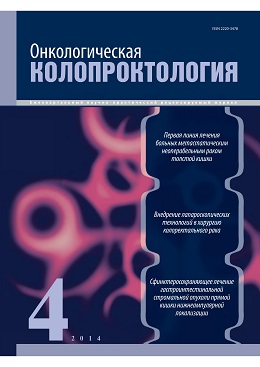Vol 1, No 4 (2012)
- Year: 2012
- Published: 01.03.2012
- Articles: 11
- URL: https://onco-surgery.info/jour/issue/view/14
 6-6
6-6


СОБЫТИЯ
 7-8
7-8


IN FOCUS
Сombined treatment of squamous-cell anal cancer
Abstract
Since 1974 chemoradiation scheme proposed by Nigro remains the standard of care for squamous-cell anal cancer in most countries. Improvement of treatment results can be achieved by developing new treatment schemes including different radio- and chemosensitizers.
Methods. Results of treatment of 157 T1–4N0–2M0 squamous-cell anal cancer patients, which underwent treatment during 1990–2012 were analyzed. Patients were divided into 3 groups: group A received hyperfractionated radiotherapy (RT) single dose 1.2 Gy bid, total dose 40–44 Gy with 3–5 sessions of local hyperthermia (HT) during treatment; group B had similar RT + HT scheme with addition of chemotherapy (CT) with cisplatin 20 mg/m2 in days 1, 3 weeks 1–4 and bleomycin 15 mg in days 2, 4 weeks 1–4; group C had RT with single dose 2 Gy, same total dose, HT and CT as in group B and additionally received metronidazole 10 g/m2 per rectum in a polymeric composition. Two weeks after 1st treatment stage a second course of RT was carried out 20–24 Gy in 2 Gy fractions in all patient groups.
Results. Sphincter-sparing treatment was carried out in 11 (50 %), 71 (80.68 %) and 44 (93.62 %) in groups A, B and C accordingly. Three year overall survival (OS) was 60.0; 82.4; 96.4 %; 3-year disease-free survival (DFS) 36.6; 69.8 and 76.3 % accordingly.
Conclusions. In our study combined treatment using radiosensitization allow to improve sphincter preservation rate to 93 %, improve OS and DFS for squamous-cell anal cancer patients.
 9-14
9-14


REVIEW
Colorectal cancer with synchronous distant metastases: rationale for cytoreductive surgery and its perspectives – a surgeons view
Abstract
A rationale for cytoreductive surgery in colorectal cancer patients with multiple liver metastases is discussed in the article. Not only does it improve their quality of life and prevent life-threatening complications, but also facilitates further systemic treatment. Symptomatic surgery (colostomies and bypass surgery) does not improve treatment outcome independent from additional treatment. Our results demonstrate that chemotherapy with 2 or more active drugs after cytoreductive surgery significantly improves treatment results. Rationale for the use of chemoradiotherapy in rectal cancer patients with synchronous distant metastases is demonstrated in the article.
 15-20
15-20


ORIGINAL REPORTS
Возможности сфинктеросохраняющего лечения больных местно-распространенным первично-неоперабельным раком прямой кишки
Abstract
The aim of this study was to compare results of sphincter-sparing operations (SSO) and abdominoperineal resections (APR) in patients undergoing combined treatment for unresectable locally-advanced rectal cancer.
Methods. During September 2007 – January 2011 59 patients were enrolled. Original treatment scheme (RF patent № 2414936) was developed including radiotherapy 40 Gy in 4 Gy fractions, capecitabine 650 mg/m2 bid per os days 1-22, oxaliplatin 50 mg/m2 iv days 3, 10, 17, local hyperthermia on days 8, 12, 15, 17, 2 applications of metronidazole 10 g/m2 per rectum in a polymeric composition. Surgery was carried out following 6–8 weeks. SSO were carried out in 36 patients, APR in 23 patients. Study endpoints included 2-year OS and DFS, local recurrence and distant metastases rate, postoperative complications rate.
Results. No significant differences in survival were observed: 2-year OS was 93.2 and 85.6 % (log- rank test p = 0.157) for SSO and APR groups accordingly, 2-year DFS was 88 and 71.9 % (log-rank test p = 0.064). Four (11.1 %) patients in SSO group and 4 (17.4 %) patients in APR group (р = 0.5511) developed local recurrences, 4 (11.1 %) and 7 (30.4 %) (р = 0.1293) developed distant metastases. Postoperative complications rate was 27.8 % (n = 10) and 39.1 % (n = 9) (р = 0.5181) in SSO and APR groups accordingly.
Conclusions. Sphincter-sparting surgery is justified for unresectable locally advanced rectal cancer when technically feasible.
 21-25
21-25


Метод оптимизации лечения рака прямой кишки, осложненного кишечной непроходимостью
Abstract
Представлены результаты изучения возможности консервативного разрешения опухолевой толстокишечной непроходимости при раке прямой кишки. Применение методики эндоскопической реканализации просвета кишечника при частичной толстокишечной непроходимости в сочетании с использованием энтеро- и колоносорбции позволяет:
1) быстро устранить симптоматику кишечной недостаточности;
2) осуществить в предоперационном периоде полноценную химиолучевую ерапию, направленную на уменьшение размеров и глубины инвазии опухоли, что способствует снижению риска рецидивов и метаста зирования опухоли;
3) облегчить проведение первично-восстановительной операции и течение послеоперационного периода; 4) добиться явного улучшения качества жизни больных без ухудшения прогноза основного заболевания.
 26-31
26-31


Comparative results of end colostomy for low rectal cancer using alloplastic material
Abstract
The results of research on the causes affecting in the development of para-colostomy complications after abdomino-perineal extirpation of the rectum for cancer patients, who were treated by us from 2005 to 2012 found that the development of complications para-colostomy affects in the age of patient, comorbidity, severity of anemia, and obesity. Allocation of risk and patient groups at increased risk for complications allows differentiated approach to their prevention.
 32-35
32-35


Современные аспекты хирургического лечения больных осложненным колоректальным раком на региональном уровне
Abstract
The high percent of patients with the complicated colorectal cancer is hospitalized in an emergency order due to disease complications, such as intestinal obstruction, tumor perforation, a regional inflammation, intestinal bleeding, anemia. Adequate oncological surgery is an important stage of treatment for these patients.
 36-38
36-38


Efficacy of polietilenglicole in bowel preparation for colorectal cancer surgery
Abstract
 39-42
39-42


CASE REPORT
Bilateral ureterostasis after rectal extirpation
Abstract
The paper describes a rare case of bilateral uterostasis that occurred in the early postoperative period in a female patient after abdominoperineal rectal extirpation and resulted in complete occlusion of both kidneys. The timely diagnosis of this rare complication could recover urinary passage along the ureters and prevent renal failure in time. The differential diagnosis of this rare complication due to intraoperative damage to the ureters (their transection or ligation) is important in medical practice.
 43-45
43-45


ПРИЛОЖЕНИЕ
 47-57
47-57











